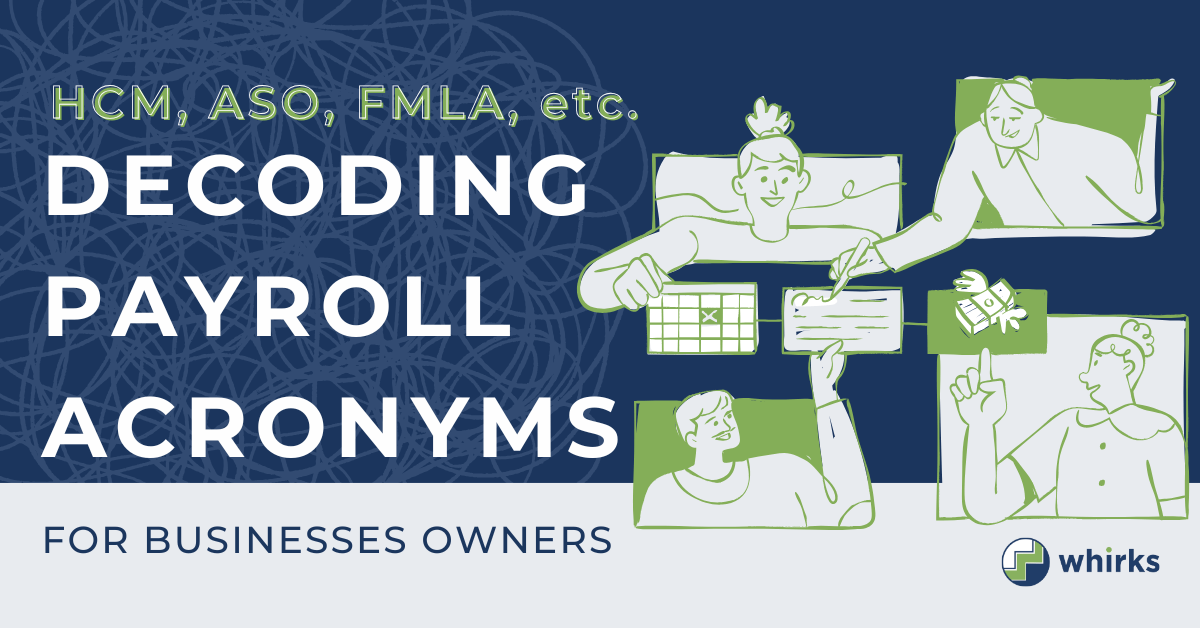HCM, ASO, and FMLA: Decoding Payroll Acronyms for Business Owners
March 28th, 2025 | 3 min. read

Ever feel like payroll professionals are speaking an entirely different language? You’re not alone. Many business owners find themselves nodding along in meetings while internally wondering, “What the heck is an ASO or HCM system?” When I first entered the payroll industry, I felt like I’d been dropped into a foreign country without a translation guide.
This alphabet soup of payroll acronyms can be confusing. And it can impact your business decisions. After all, how can you choose the right payroll services when you don’t understand what’s being offered?
As payroll experts who have guided countless business owners through this terminology maze, we’ll translate the most common payroll terms you’ll encounter. By the end of this article, you’ll confidently know your FICA from your FUTA and understand what an HCM system actually does for your business.
Essential Payroll and HR Acronyms Every Business Owner Should Know
Let’s break down the most common acronyms you’ll encounter in the payroll world. Think of this as your personal translation guide for those conversations with payroll providers, HR professionals, and benefits administrators. We’ve organized these terms and categories to help you better understand how they relate to different aspects of your business operations.
Basic Business and Employee Terms
- EE: Employee
- EA: Enrolled Agent (a tax professional licensed by the IRS)
- DBA: Doing Business As
- EIN: Employer Identification Number
- PEPM: Per Employee/Per Month (a common pricing model for payroll services)
Payroll Systems and Service Providers
An HCM system is comprehensive software that manages all employee-related processes throughout their entire lifecycle with your company:
- Pre-employment (recruitment, applicant tracking)
- Employment (payroll, benefits, time tracking, performance management)
- Post-employment (offboarding, compliance documentation)
Unlike basic payroll software, an HCM system provides tools to help you maximize your workforce's potential while streamlining administrative tasks.
- ASO: Administrative Services Organization. An organization that provides outsourced solutions for administrative needs, with you retaining all employment-related risks and liabilities.
- PEO: Professional Employer Organization. Similar to an ASO but operates under a co-employment model where the PEO assumes some employer liabilities.
- ATS: Applicant Tracking System. Software that manages your recruitment process and serves as a database for job applicants.
Employee Classification and Verification
- E-Verify: A web-based system that confirms employee eligibility to work in the United States.
- Exempt Employee: An employee who doesn’t receive overtime pay, typically because they’re salaried and perform specific duties defined by the Department of Labor.
Workers’ Compensation and Tax Credits
- PAYGO: Pay-as-you-go workers’ comp. A method for reporting payroll figures to your workers’ comp insurance provider that eliminates year-end policy adjustments. You pay based on actual payroll data instead of estimates.
- ERC: Employee Retention Tax Credit. A refundable tax credit against certain employment taxes available during parts of 2020 and 2021.
Decoding Benefits and Compliance Terminology
Benefits and compliance form the backbone of your employer responsibilities and often come with the most complex terminology. These acronyms frequently appear in legal documents, tax forms, and discussions with your payroll provider. Understanding these terms is particularly crucial because misinterpreting them can lead to costly compliance issues or penalties. Here’s what you need to know:
Benefits Administration
- BA: Benefits Administration. The process of creating, managing, and updating your organization's employee benefits program, including health insurance, retirement accounts, PTO, and parental leave.
Tax and Legal Compliance
- FICA: Federal Insurance Contributions Act. The taxes that fund Social Security and Medicare. The total due is 15.3% of wages—half paid by the employee and half by the employer.
- FUTA: Federal Unemployment Tax Act. Legislation allowing government taxation of businesses to fund state unemployment agencies.
- COBRA: Consolidated Omnibus Budget Reconciliation Act. Gives workers who lose health benefits the right to continue group health coverage temporarily under certain circumstances like job loss or reduced hours.
- FMLA: Family and Medical Leave Act. Entitles eligible employees to take unpaid, job-protected leave for specified family and medical reasons.
- FLSA: Fair Labor Standards Act. Establishes minimum wage, overtime pay, recordkeeping, and youth employment standards.
From Alphabet Soup to Fluent Payroll Speaker
While we haven't covered every term in the payroll and benefits industry, this guide gives you a strong foundation. Don’t hesitate to ask your payroll provider to explain unfamiliar terminology—remember, you don't know what you don't know.
With time, you’ll become fluent in this specialized language. Though it may not flow as naturally as French or Spanish, understanding payroll terminology is essential when building your business.
At Whirks, we specialize in translating complex payroll concepts into plain English. Beyond guiding you through industry lingo, we help you navigate common frustrations and answer critical questions like, “When should I have a separate legal entity for my small business?”
Want to ensure you’re avoiding common payroll pitfalls? Our guide on how to avoid the most common payroll mistakes business owners make will help keep your business running smoothly.
Topics:
